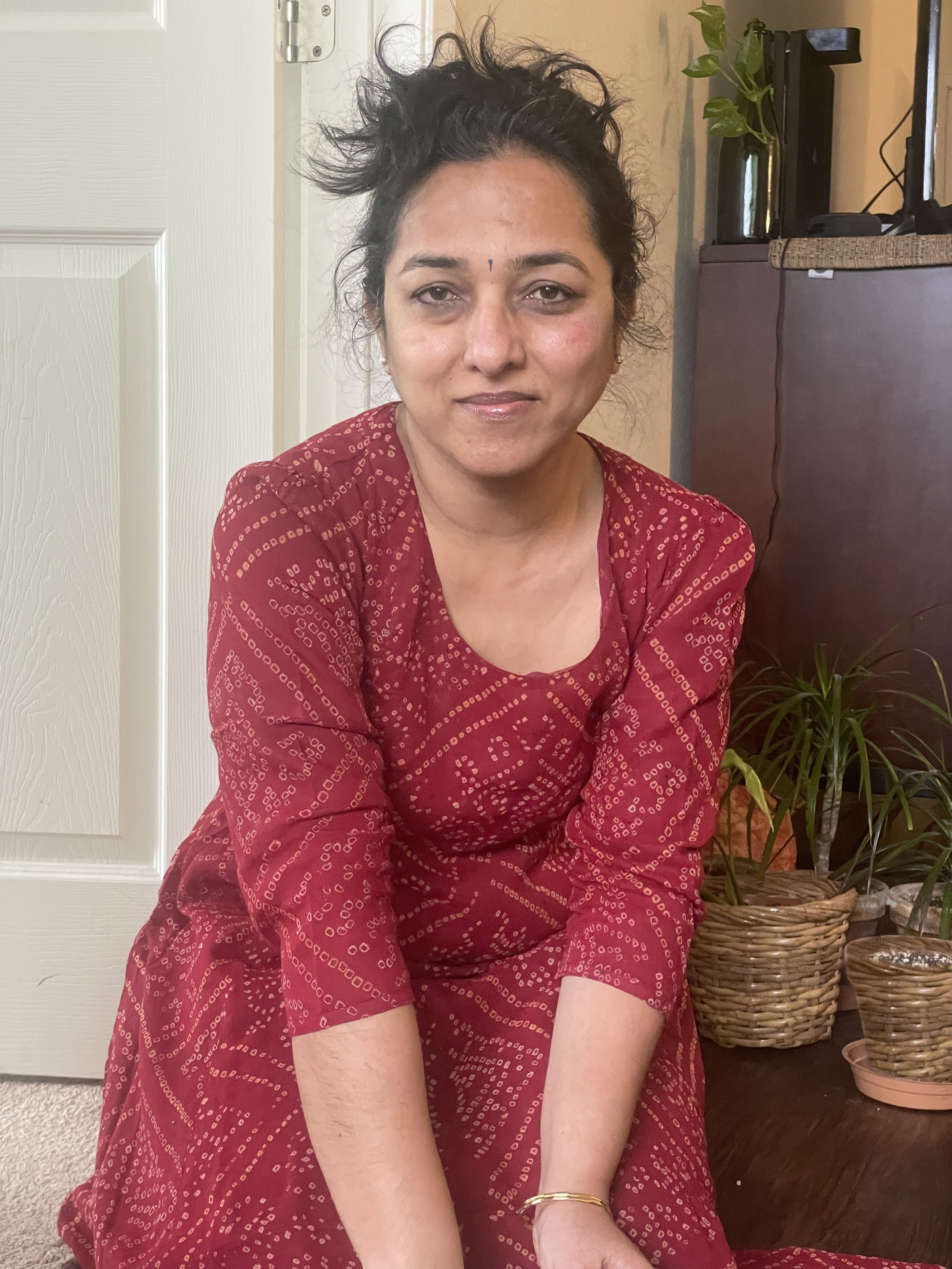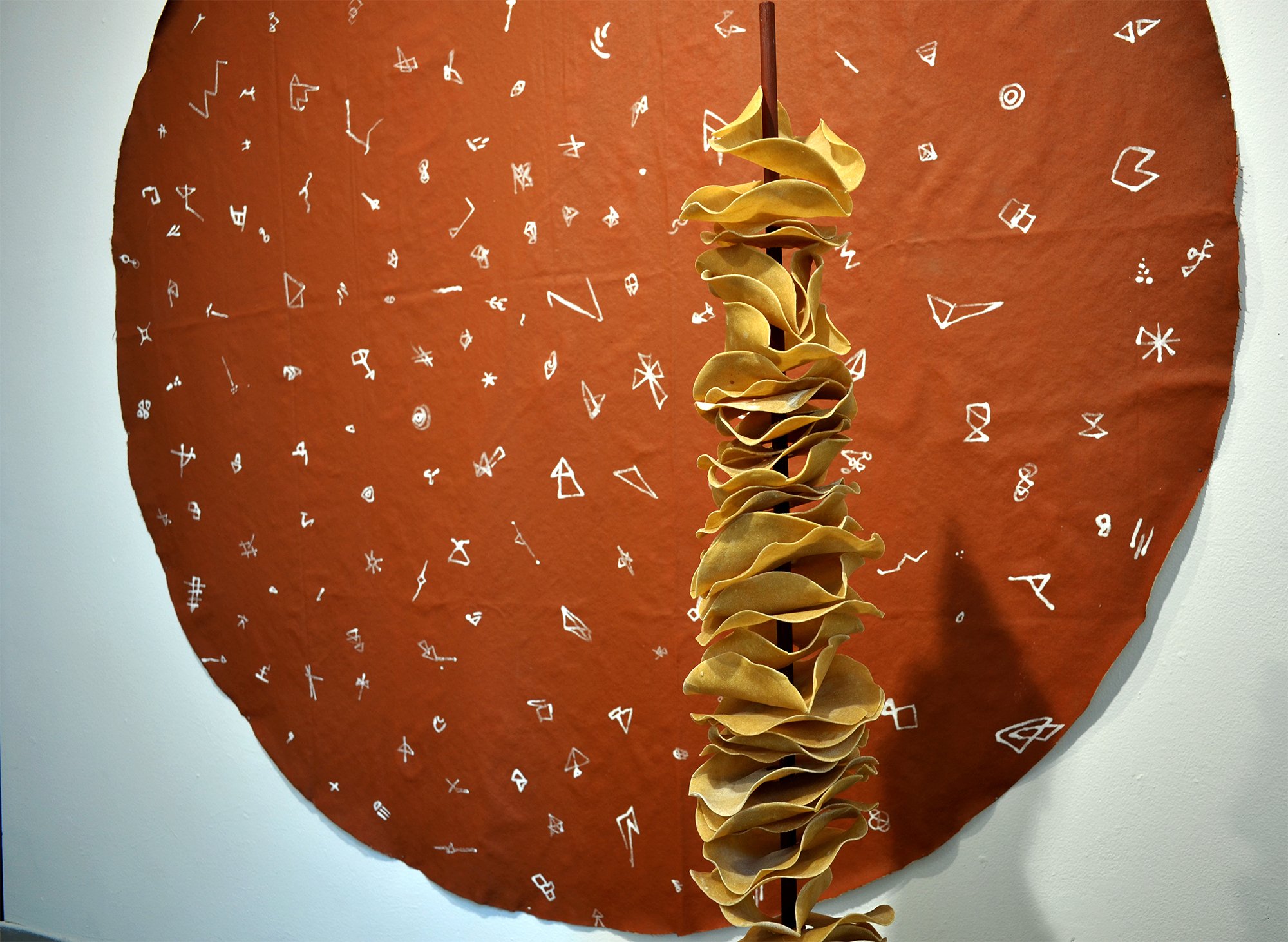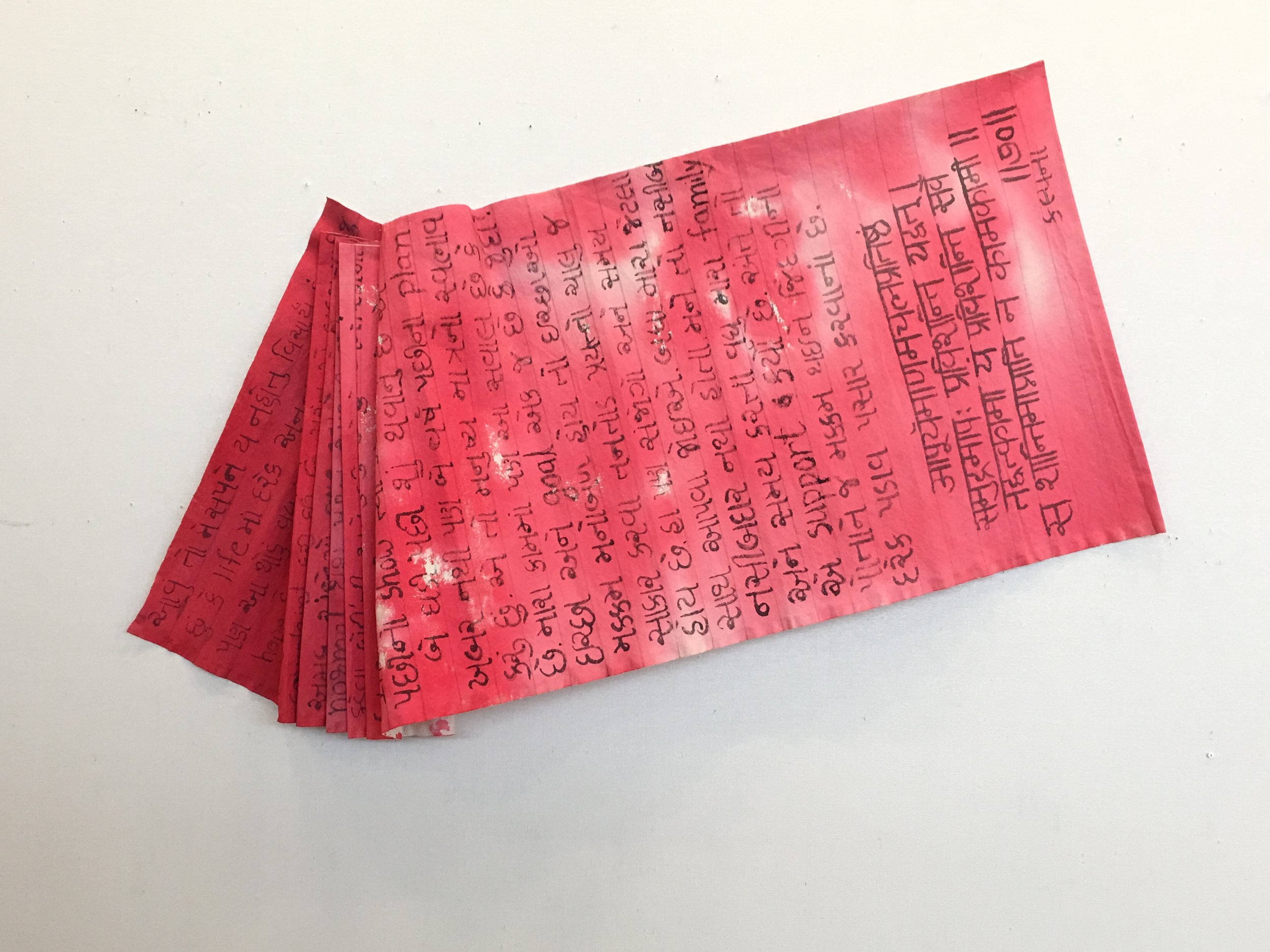Kalpana Vadnagara
Photo courtesy of the artist
Damaris Athene: Could you start off by telling me a bit about yourself, please?
Kalpana Vadnagara: Yeah, I'm a visual artist born and raised in India and currently living and working in California, US. I received my Bachelors in Mathematics in India and then I moved to the US. I received my MFA in craft from Oregon College of Art and Craft, Portland, Oregon. When I realised my passion for art, I was too busy raising my two sons and had a lot of other family responsibilities, so I had to wait until my kids were grown up and went to high school. In India, due to age limit restrictions, I couldn't attend the fine art school. So I held my desire to study art until I moved to the US.
DA: What brought you down to California?
KV: My whole family is in California.
DA: Did your husband and sons come with you when you went to Portland?
KV: No, it was just me, by myself. My sons were in school and my husband had a job there in California. My family supported me financially. It was a tough decision.
DA: That must have been really difficult to be apart from them for so long.
KV: Yeah, I cried a lot.
DA: How tough! What do you explore in your practice?
KV: After doing my MFA here in the United States, I was able to combine my Indian roots with the art exposure that I received at my school. I created a hybrid art practice that enabled me to view Indian subject matter through a Western lens. My mixed media work allows me to experiment with Western art using religion and culture. My practice is specific to my experience as a woman from India. My practice is focused on Indian Women's daily life and their religious rituals. I characterise rituals as a subject while also using it as a strategy.
Wedded (51), 2019, Rice Paste, House Paint on Canvas, Wheat Flour, Concrete & Wood, 57” x 57” & 11” x 11” x 37”
Photo courtesy of the artist
DA: So it's the subject but it's also the medium of the work and the process behind the work?
KV: Yeah.
DA: What are the rituals?
KV: The rituals are mundane, things like cooking, worship, prayers. It is everyday life, but I focus only on women's rituals.
DA: Could you expand on how you explore the domestic and women in your practice?
KV: I believe that women dedicate their lives to their family and community by putting others needs before their own. Still their sacrifice often doesn't get acknowledged. Indian society views the daily tasks of women as mundane rituals that lack imagination and skill. I question these value judgments hidden in the word mundanity. These daily rituals of Indian women have a profound effect on Indian society and it inspires my creativity. My work is informed by my cooking practice. I might my process is very much similar to my cooking. I merge contemporary artistic investigation with the traditional sense of ritual and responsibility reflected in domestic work.
DA: Are you the sole cook in your house?
KV: I have taught my two sons how to cook and they both cook very well. They both have inspired my husband, so now he can also cook!
DA: That's amazing!
KV: It's very unusual in Indian culture.
Ganesh Chaturthi, 2018, Concrete, House paint, Turmeric & Cheesecloth, Size Variable
Photo courtesy of the artist
DA: What different media do you use in your work? And what symbolism can these materials have?
KV: I started my art practice with drawing and painting when I joined the community college but then when I went to do my MFA, it was a different kind of school, and now I use mixed media including digital art, ceramics, installation, and social art. I've been using materials from my daily life as an inspiration. This could include ingredients from the kitchen, like wheat flour, rice, and all my spices, and also materials from my mother's shrine like pigments that she uses for her idols, red thread which we call ‘Nadachadi’, it’s a very significant material, and her faith. It has helped me to recognise my utmost admiration and respect for women who work so hard with no expectations for their loved ones. Another medium that I started using is language. It’s become a core ingredient of my practice, because I understand that language plays a significant role for any culture, but as an immigrant, translation is a pivotal part of my daily life in the US.
DA: How was your English before you move to the US?
KV: I mean, I've never talked in English before, but I raised my two sons and they were studying in English medium. I was teaching them up to high school so I was familiar with the English language. After coming here, language was a barrier for me.
DA: What's your native language?
KV: Gujarati.
DA: So very different in structure.
KV: Yeah very different. Hindi as the Indian national language, so I know Hindi very well, too.
Unposted, 2018, Kanku & Ink on Canvas, Size Variable
Photo courtesy of the artist
DA: You’re trilingual! That's very cool! How do you usually work and have you found that that's been affected by the pandemic?
KV: Usually, I work in my home studio. I'm fortunate enough to have an amazing supportive family who encourage me spending time and energy on my passion. The pandemic didn't change much of my work style. However, I was planning a lot of projects which needed social gatherings and I had to put them on hold. I would definitely admit that the pandemic has changed my mindset, I have become more aware of uncertainty and I have learnt to be more flexible and to not stress over small things.
DA: All important things to learn. With the social element of your practice, what form does that normally take?
KV: I did some projects before, where I made roti, which is an Indian daily food. I got the audience to make roti and I asked them why it's not art. You need to understand the consistency of the flour. For me the consistency is similar to clay. I did another project where I was cooking in front of the audience. They were all there helping me while also taking turns doing other activities, kind of creating a family type of environment where everyone can sit, cook together, discuss, enjoy and relax. I want to take that to galleries and other public places.
DA: That sounds amazing. Maybe now that things are calming down, you might be able to. What would you like people to get from your work?
KV: I want my work to be viewed as a celebration of culture, rituals, prayers, language, beliefs, and faith. I want all those routinely rituals that go unnoticed to be noticed and also get appreciated. I want to embrace the wealth of my culture and my femininity.
Memory Box, 2018, Ink on Paper, Rice, Sugar, Turmeric, Kanku (Red Pigment), Red Sacred Thread, 12” x 12”
Photo courtesy of the artist
DA: Have you had any surprising or memorable reactions to your work?
KV: Yeah, years ago, I created an artwork for a group show, which was kind of a memory box. It was a combination of a candy box, and a worship offering box that I have always seen in the temples. As a child, I recall seeing that offering box with ingredients used in common worshipping, like Prasad. Prasad means holy offering. If you go to the temple, there will be a box, and you can do your prayers and take Prasad with you. I wanted to reference that and incorporate it in my work. So I created 54 small 5cm by 5cm watercolour paintings on paper from my childhood memories. I displayed them in the box with all the other ingredients. One day I received a phone call from an old lady who wanted to buy some of my smaller watercolour works for her grandson. I informed her that they weren’t for sale and she mentioned that some of her friends had taken some of my watercolour works from the exhibition, thinking they were for the visitors. This reflected the exact same practice where the holy offering is taken by the visitors. Unknowingly, someone reacted the same manner and I was able to make a connection in two different worlds. It was surprising! I didn't think that would happen in a gallery with a camera, security and a ticket to enter.
DA: Were you upset that you didn't have that work anymore?
KV: At first, I was little bit upset. But then I felt like the meaning of that work came through. It touched my heart and I feel like it’s the most memorable work because of that reaction.
DA: It’s interested when you can bridge two worlds with your work. Whose work inspires you?
KV: That is difficult to say a few because I admire and enjoy many artists’ work. I love Janine Antoni's work. I feel like I can easily connect her process with my work. She uses her body to transform the everyday activities such as sleeping, eating, and bathing into ways of making art similar to my transformation with religious and domestic rituals. I was inspired by her work, especially her wonderful work made out of chocolate, soap and lard. Another great inspiration is Zarina Hashmi. She is a minimalist but her work is very sensitive and very intriguing to me. Of course, my mother, my mother in law and all the women around me are inspiring too. An Indian artist called G.R. Iranna, who also works with similar concept like Indian culture and religious rituals, has also influenced my work. Recently, I changed job and now I have to commute for three hours each day. I’ve started listening to podcasts which are so amazing. They’ve introduced me to so many artists.
What Matters?, 2018, 3D Printing, Yarn & Turmeric, Size Variable
Photo courtesy of the artist
DA: Which podcast would you recommend?
KV: There are so many. Two of my favourites are Conversations About Art by Heidi Zuckerman and The Great Women Artists by Katy Hessel.
DA: What projects have you been working on recently?
KV: I'm working on three projects at the moment. I cannot work on only one project, just like when I’m cooking and I have four stoves on. All my projects include language, cooking, religion, and ritual. I'm embroidering 27 Nakshatras on window screens. Nakshatras are lunar mansions, segments of the ecliptic through which the Moon passes in its orbit around the Earth. They’re very significant in our culture.
DA: Wow!
KV: Another project is an extended version of my previous work named 'Not Me’ where I translated my name in 132 languages. It's kind of a prayer. I was inspired by my mother doing Sahasranama, a prayer where you repeat Shiva's or Vishnu’s name 1000 times. I translated my name because I feel like that is most familiar thing to me. I dyed my canvas with turmeric, wrote my name with charcoal and then I dyed it again so that all the languages became one language. I did this about 10 times. This time I'm writing in a book. It's a long process! I’m recording it and will exhibit it as a video of the process. It's a kind of performance, but not in front of the public. For the third project I am making the phases of the moon in clay. In India we use a lunar calendar.
DA: Do you have any other plans for future work?
KV: I have just signed up to volunteer for a senior community in Brooklyn, New York. I have to teach them art online because they are all vulnerable and isolated. I'm also hoping to make my social practice more artistic. In my family, we sit in a circle every evening at Sandhya, twilight time, do our prayers and then all take turns speaking about our day. I’d planning to do that at the library or the park and I'm planning to go to India and document the daily rituals of women.
DA: I look forward to seeing all these projects come to life! Thanks so much Kalpana.
KV: Thank you!
Mercury, 2022, Moving Image, 0:32 - “As young girls in India we are told that if we can’t make a roti into a perfect circle, we will never get a good husband. In reflecting on this custom I was struck by the artistry involved in making a perfectly round roti.”






